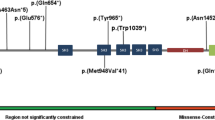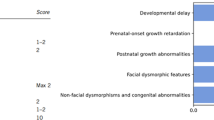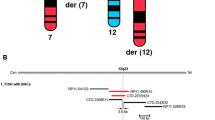Abstract
Mental retardation is a frequent condition that is clinically and genetically highly heterogeneous. One of the strategies used to identify new causative genes is to take advantage of balanced chromosomal rearrangements in affected patients. We characterized a de novo t(10;13) balanced translocation in a patient with severe mental retardation and major hypotonia. We found that the balanced translocation is molecularly balanced. The translocation breakpoint disrupts the coding sequence of a single gene, called ATP8A2. The ATP8A2 gene is not ubiquitously expressed, but it is highly expressed in the brain. In situ hybridization performed in mouse embryos at different stages of development with the mouse homologue confirms this observation. A total of 38 patients with a similar phenotype were screened for mutations in the ATP8A2 gene but no mutations were found. The balanced translocation identified in this patient disrupts a single candidate gene highly expressed in the brain. Although this chromosomal rearrangement could be the cause of the severe phenotype of the patient, we were not able to identify additional cases. Extensive screening in the mentally retarded population will be needed to determine if ATP8A2 haploinsufficiency or dysfunction causes a neurological phenotype in humans.
Similar content being viewed by others
Log in or create a free account to read this content
Gain free access to this article, as well as selected content from this journal and more on nature.com
or
References
Leonard H, Wen X : The epidemiology of mental retardation: challenges and opportunities in the new millennium. Ment Retard Dev Disabil Res Rev 2002; 8: 117–134.
Chelly J, Khelfaoui M, Francis F, Beldjord C, Bienvenu T : Genetics and pathophysiology of mental retardation. Eur J Hum Genet 2006; 14: 701–713.
Higgins AW, Alkuraya FS, Bosco AF et al: Characterization of apparently balanced chromosomal rearrangements from the developmental genome anatomy project. Am J Hum Genet 2008; 82: 712–722.
Vandeweyer G, Kooy RF : Balanced translocations in mental retardation. Hum Genet 2009; 126: 133–147.
Andrieu D, Watrin F, Niinobe M, Yoshikawa K, Muscatelli F, Fernandez PA : Expression of the Prader-Willi gene Necdin during mouse nervous system development correlates with neuronal differentiation and p75NTR expression. Gene Expr Patterns 2003; 3: 761–765.
Coleman JA, Kwok MC, Molday RS : Localization, purification, and functional reconstitution of the P4-ATPase Atp8a2, a phosphatidylserine flippase in photoreceptor disc membranes. J Biol Chem 2009; 284: 32670–32679.
Sun XL, Li D, Fang J et al: Changes in levels of normal ML-1 gene transcripts associated with the conversion of human nontumorigenic to tumorigenic phenotypes. Gene Expr 1999; 8: 129–139.
Halleck MS, Lawler JF JR, Blackshaw S et al: Differential expression of putative transbilayer amphipath transporters. Physiol Genomics 1999; 1: 139–150.
Li MO, Sarkisian MR, Mehal WZ, Rakic P, Flavell RA : Phosphatidylserine receptor is required for clearance of apoptotic cells. Science 2003; 302: 1560–1563.
Walczak-Sztulpa J, Wisniewska M, Latos-Bielenska A et al: Chromosome deletions in 13q33-34: report of four patients and review of the literature. Am J Med Genet 2008; 146: 337–342.
Nichols KE, Walther S, Chao E, Shields C, Ganguly A : Recent advances in retinoblastoma genetic research. Curr Opin Ophthalmol 2009; 20: 351–355.
Drummond-Borg M, Kulharya AS, Tonk V, Garcia-Heras J : Maternal complex chromosome rearrangement ascertained through a del(13)(q12.1q14.1) detected in her mildly affected daughter. Am J Med Genet 2002; 107: 61–63.
Brown S, Gersen S, Anyane-Yeboa K, Warburton D : Preliminary definition of a ‘critical region’ of chromosome 13 in q32: report of 14 cases with 13q deletions and review of the literature. Am J Med Genet 1993; 45: 52–59.
Acknowledgements
We thank the Centre de Ressources Biologiques of La Timone Children's Hospital for access to the biological samples used in this study, and the microarray core facility of the Department of Medical Genetics of La Timone Children's Hospital. We thank Dr Jean-Christophe Roux for helpful discussions.
Author information
Authors and Affiliations
Corresponding author
Ethics declarations
Competing interests
The authors declare no conflict of interest.
Additional information
Supplementary Information accompanies the paper on European Journal of Human Genetics website
Rights and permissions
About this article
Cite this article
Cacciagli, P., Haddad, MR., Mignon-Ravix, C. et al. Disruption of the ATP8A2 gene in a patient with a t(10;13) de novo balanced translocation and a severe neurological phenotype. Eur J Hum Genet 18, 1360–1363 (2010). https://doi.org/10.1038/ejhg.2010.126
Received:
Revised:
Accepted:
Published:
Issue date:
DOI: https://doi.org/10.1038/ejhg.2010.126
Keywords
This article is cited by
-
Biallelic truncation variants in ATP9A are associated with a novel autosomal recessive neurodevelopmental disorder
npj Genomic Medicine (2021)
-
Genome-wide association study for postweaning weight traits in Lori-Bakhtiari sheep
Tropical Animal Health and Production (2021)
-
ATP8A2-related disorders as recessive cerebellar ataxia
Journal of Neurology (2020)
-
Chorea in children: etiology, diagnostic approach and management
Journal of Neural Transmission (2020)
-
Proteomic Analysis and Functional Characterization of P4-ATPase Phospholipid Flippases from Murine Tissues
Scientific Reports (2018)



